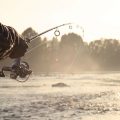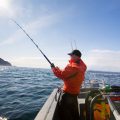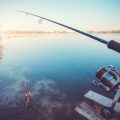Do not allow yourself to be let down by a damaged fishing rod. Here are some of the most common issues and solutions on how to repair fishing rod. Sometimes certain circumstances might transpire while fishing, which can do damage to your rod. It is best if you come prepared so you will be able to provide the rod with the best solutions and allow yourself to proceed with your hobby.
Thankfully, some common issues are often not that hard to fix. All you need for these steps are just a few items and you will be good to go.
To repair a broken fishing rod, you need the following items: replacements for the broken parts, fast-acting epoxy, lacquer, a knife or scissors. These items are easy to find and they can be bought at any sporting goods shops.
- Examine the damage that was done on the fishing rod so you will know what you need to get in order to fix it.
- Repair a broken guide by clipping the string that holds it to the rod. Get rid of the old guide and string. Position the new guide in place and be certain that it is lined up properly with the others. Secure the guide by binding a new string all over it and the rod. Put a thin coating of lacquer to the replacement string in order for it to cure and maintain the brand new guide in position.
- Repair a broken tip by clipping off the ragged, broken end of the rod. Position the replacement tip on the rod’s end to guarantee that it fits correctly. Line up the tip with the guides and then glue the tip in position with the epoxy. You can use the rod once more when the epoxy dries up.
- Repair a broken rod by first clipping the damaged and ragged ends because you need to have a rod that has a neat, square edge. Glue the ferrule with the epoxy to the rod’s bottom half part. Go over this step again by gluing the ferrule’s other end to the top half part of the rod. You can buy the ferrules at any sporting goods shop. You can use the rod again when the epoxy dries up.
In case you have a damaged rod that’s considered special or an antique, it will be better if you take the item to a professional for repairs.
You can also create your own portable repair kit for angling/fishing. This is to ensure that you will be prepared in case any of those issues occur on your rod. The repair kit can contain a variety of items or just replacements for any of those rod parts. You can make that kit into a basic one or fill it with additional items aside from the essentials.
Proper Fishing Rod Care and Maintenance
The fishing tackle that you own will help you acquire that elusive catch. That is why you have to keep them in excellent condition at all times. Providing them the care and maintenance they need will help them last longer as well. There is nothing more bothersome than losing a good catch because of a damaged rod or grip. Prevent those problems from happening by always keeping watch over your rods. Spend a bit of time to care for it properly when it is being used or is placed in storage.
- Make use of a mesh rod cover when carrying your fishing rods to the ramp of the boat or when putting them for storage in the rod locker of the vessel. Fishing rod covers help when it comes to preventing the lines from tangling and knotting. The rod covers will also act as some sort of padding to help safeguard them from the guides and the blanks. These rod covers that are made with mesh material come in a wide selection of colors so you can do some color-coding on every rod you use, thereby making them more accessible.
- Maintain the rod’s form and make sure that they are side by side. Place them inside the rod lockers to holders. When the vessel or boat is running, those guides, blanks, and reels can get abraded, dented or knocked around because of the vibrations.
- As soon as you are done with angling or fishing for the day, take away lures or hooks that may get snarled in the lines, on yourself or the upholstery of your car.
- Wash your fishing tackle with fresh water to get rid of grit, sand, dirt or saltwater When your gear is completely dry, wipe them off with a soft, clean cloth and make use of a reel lubricant to keep the parts of the reel neat and in tiptop shape.
- Store your angling gear in a correct storage meant for fishing rods. A proper storage means the rods will maintain their form and prevent parts from knocking against each other. Do not store the rods upright because they will lean against each other and may damage their form eventually. Items like the guides, tips, and blanks are more prone to damage if you store them in that manner. Keep them in a safe corner of your tool shed or garage.
- In case you are keeping your reels for more than 2 days, it is suggested that you slacken the drag so that the line will not drag down the rods or break them.
Applying these tips for maintaining your reel and rods’ integrity will make them last longer. Not only that, it will also help you save money and effort on avoidable repairs and refurbishments. Storage for fishing rods can be an essential factor when it comes to considering the kind of vessel that suits the kind of fishing or angling that you want to do as well. The reel and the rod are often on the expensive side, so it is wise to practice maintenance and give it the care it deserves.











